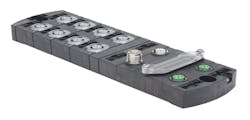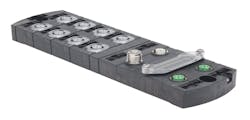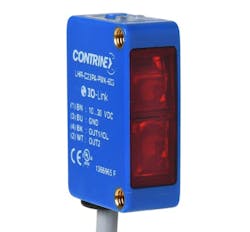How Smart Process Sensors Benefit Discrete Manufacturing
Common to all types of manufacturing automation is a reliance on effective detection and measurement of real-world conditions. In the past, discrete manufacturing (production of parts and equipment) largely depended on basic hardwired discrete (on/off) and analog sensors, while process operations (continuous chemical production) used more sophisticated and complex instruments, often with enhanced digital capabilities.
Although there can be a tendency for users to associate certain automation types with specific purposes and industries, the reality for most users is that constantly improving measurement and control technologies are providing improved options and possibilities across the entire spectrum of applications.
This is especially the case as technologies formerly available only with the leading process measurement applications become more ubiquitous. More intelligent discrete and analog field devices, combined with better connectivity methods and other digital developments, are making advanced sensors and instruments more accessible for discrete manufacturing applications.
Improving the connection
Instrument connectivity determines how well a device interacts with a host controller, such as a programmable logic controller (PLC). Traditional discrete manufacturing designs have used predominantly hardwired input/output (I/O) points, such as 24V dc for discrete signaling and 4- 20mA for transmitting analog values. Basic hardwired I/O transmits just one value, such as status or the process variable, from the field to the host. Users must go to the field device to configure and troubleshoot it.
An industrial network enables the host to gather much more process data and other diagnostics, and to send command and configuration data to the intelligent field device. However, a typical industrial network may involve special media/cables, careful implementation of termination resistors, restrictive design and installation standards, use of a Class 2 power supply, additional configuration software, and significant training and effort to commission the network.
Capable digital networks, such as Modbus serial or DeviceNet, have been available for decades, but many individual field devices used with machinery don’t support these buses because the initial cost, and the complexity of installation and operation, are prohibitive. Other industrial Ethernet networks—such as EtherNet/IP and Modbus TCP—have become popular, but again they may not be offered natively on individual discrete manufacturing devices and are somewhat less suitable for running directly to a multitude of field locations. Some users have taken advantage of the HART over analog 4-20mA, but this doesn’t address discrete devices.
To address these and other issues, the recent development and adoption of IO-Link, as specified in IEC 61131-9, now provides a cost-effective and fit-for-purpose standard to support bi-directional communications of up to 32 bytes of data between a controller and a field device.
IO-Link is economical to install in the field using standard unshielded three-wire cable to provide power and signal for each device, at distances of up to 20 meters from hubs to field devices. The architecture is flexible and uses “master modules” and “hubs,” which are available in IP67- rated versions, can be installed on machines and use key-coded M12 connectors and cables.
These master modules and hubs connect to the host using protocols such as EtherNet/IP and work as efficient and reliable digital gateways between many field devices and a host. Typically, no special software is needed, while an I/O Device Description (IODD) device profile supplies the detailed information about capabilities for each type of device.
Many discrete field sensors and devices now incorporate IO-Link, such as:
- photoeyes
- proximity sensors (ultrasonic, inductive, capacitive)
- capacitance level switches
- pushbuttons and beacons. In addition, analog process sensors for flow, level, pressure and temperature are available with IO-Link technology.
In addition, analog process sensors for flow, level, pressure and temperature are available with IO-Link technology.
Using IO-Link, designers gain significant capabilities with each field device, such as:
- Transmitting the primary process value, along with additional values and status information.
- Receiving extended diagnostic information to support troubleshooting.
- Communicating with field devices from the host for configuration.
The host PLC platform must be IO-Link capable, and it should support the IODD files supplied with field instruments for best compatibility. Once an IO-Link system is commissioned, users can quickly replace any failed sensor and all configuration parameters will be automatically restored to the new device, speeding and simplifying maintenance. IO-Link field devices can also operate in a standard I/O (SIO) mode, so users can stock fewer device models and choose whether to use them as SIO or IO-Link.
Simplifying sophistication
As field devices, especially analog sensors/transmitter instruments, become more intelligent and capable, it is often necessary for users to perform certain configuration and calibration tasks at the instrument itself. Some common examples are a radar liquid level transmitter or a magnetic flow meter.
While these devices may offer a pushbutton interface on the device itself, there is an easier and more convenient approach gaining popularity which uses standard Bluetooth wireless connectivity and a mobile app offered by the instrument supplier.
Using a Bluetooth mobile app, users need only be within about 32 feet of the target instrument to securely connect with it (see Endress + Hauser Bluetooth image). This is especially advantageous for instruments located in hazardous or difficult-to-access locations. The user can commission the instrument and then interact with it during operation in real-time to obtain process information and diagnostics.
Mobile apps, using industry-standard wireless, are a key method for making leading process automation technologies more readily accessible for a wider range of applications, without requiring users to undertake extensive training on new and unfamiliar devices.
There are only a handful of instruments that support both IO-Link and Bluetooth now, but many more will be available soon. Using one or both of these technologies provides discrete manufacturing designers and OEMs with better ways of automating equipment and systems while speeding and simplifying development and support efforts.
Kevin Kakascik is a technical marketing engineer at AutomationDirect. Over his 20+ year career he has held controls engineering positions for machine OEMs, entertainment industry systems integrators, and material handling systems integrators where he estimated, designed, commissioned and started up systems.
About the Author

Leaders relevant to this article:




